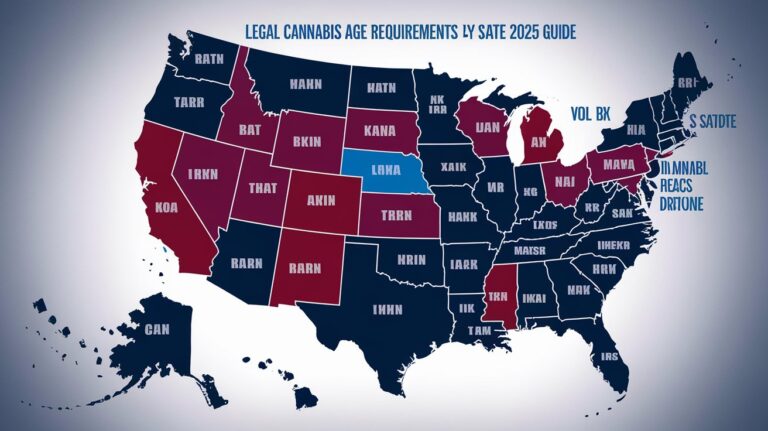How Cannabis Legalization Works in the US: Complete 2025 Guide
Cannabis legalization in the United States operates through a complex framework of federal and state laws that continue evolving in 2025. While cannabis remains federally illegal under the Controlled Substances Act, individual states have implemented their own legalization systems for medical and recreational use. Understanding how this dual legal system works is crucial for navigating the current cannabis landscape across America’s patchwork of regulations.
Federal vs State Cannabis Laws Framework
The foundation of how cannabis legalization works in the USA centers on the tension between federal prohibition and state-level legalization. The federal government classifies cannabis as a Schedule I substance, meaning it remains illegal federally regardless of state laws. However, the Department of Justice has generally adopted a hands-off approach to enforcement in states with robust regulatory frameworks.
This creates a unique situation where legal marijuana states operate within a federal gray area. As of 2025, 24 states plus Washington D.C. have legalized recreational cannabis, while 38 states allow medical marijuana use. The legal marijuana states map 2025 shows significant expansion from previous years, with more states joining the legalization movement.
Current Federal Cannabis Status
Under federal law, cannabis remains classified alongside substances like heroin and LSD. The Controlled Substances Act of 1970 established this classification, and despite numerous legislative efforts, comprehensive federal legalization has not occurred. The federal legalization timeline remains uncertain, with various bills proposed in Congress but none achieving full passage as of 2025.
State Authority in Cannabis Regulation
Individual states exercise significant authority in determining their cannabis legalization policies within their borders. States can establish comprehensive regulatory frameworks covering cultivation, manufacturing, testing, distribution, and retail sales. This state-level control allows for diverse approaches, from highly regulated markets to more liberal policies that prioritize social equity and criminal justice reform.
Decriminalization vs Legalization: Key Differences
Decriminalization vs legalization represents two distinct approaches to cannabis policy reform. Decriminalization typically removes criminal penalties for personal possession while maintaining prohibition on sales and distribution. Legalization, conversely, creates regulated markets with licensed businesses operating under state oversight.
Examples of decriminalization include states like Virginia and Minnesota (prior to full legalization), where possession of small amounts resulted in civil fines rather than criminal charges. Legal states like California and Colorado have established comprehensive regulatory systems covering the entire cannabis supply chain from seed to sale.
How State Legalization Systems Actually Work
Understanding how legalization works requires examining the regulatory mechanisms states employ. Most legal marijuana states follow a licensing system where businesses must obtain permits for different activities: cultivation, manufacturing, testing, transportation, and retail sales. These licenses come with strict compliance requirements, taxation obligations, and ongoing regulatory oversight.
States typically establish cannabis control boards or similar agencies to oversee the industry. These bodies create regulations covering everything from product testing and labeling to advertising restrictions and social equity programs. The recreational legalization process often begins with voter initiatives or legislative action, followed by regulatory development and market launch.
Licensing and Regulatory Compliance
The licensing process forms the backbone of legal cannabis operations. Applicants must demonstrate financial capability, security plans, compliance protocols, and often community benefit programs. Background checks, residency requirements, and application fees are standard across most legal states. Many states implement social equity provisions to ensure communities disproportionately impacted by prohibition benefit from legalization.
Taxation and Revenue Generation
Cannabis legalization generates significant tax revenue through various mechanisms. States typically impose excise taxes, sales taxes, and sometimes cultivation taxes. California’s complex tax structure includes cultivation taxes per ounce and percentage-based excise taxes. These revenues often fund regulatory oversight, social equity programs, and community reinvestment initiatives in areas previously impacted by cannabis prohibition.
Most Cannabis-Friendly States in 2025
When examining what state is the most 420 friendly, several factors come into play: possession limits, home cultivation allowances, consumption venues, and overall regulatory approach. California, Colorado, and Oregon consistently rank among the most cannabis-friendly states due to their mature markets, liberal possession limits, and comprehensive home cultivation rights.
Colorado allows adults to possess up to one ounce of flower and grow six plants at home. California permits possession of up to one ounce and six plants, with some localities allowing higher limits. These states also feature robust retail networks, consumption venues, and diverse product offerings that make them particularly friendly to cannabis users.
Benefits and Challenges of Cannabis Legalization
What are two positives recreational legalization brings? First, legalization significantly reduces incarceration rates and criminal justice costs associated with cannabis prohibition. States report dramatic decreases in cannabis-related arrests, freeing up law enforcement resources for serious crimes. Second, regulated markets ensure product safety through mandatory testing for pesticides, heavy metals, and potency, protecting consumer health.
However, cannabis legalization also presents challenges. Banking restrictions due to federal prohibition complicate business operations, forcing many cannabis companies to operate primarily in cash. Interstate commerce remains prohibited, limiting market efficiency and increasing costs. Additionally, impaired driving detection and prevention remain ongoing concerns for public safety officials.
Economic Impact and Job Creation
The economic benefits of legal cannabis extend beyond tax revenue. The industry creates jobs across multiple sectors: cultivation, manufacturing, retail, testing, security, and ancillary services. Colorado’s cannabis industry employs over 40,000 people directly, with thousands more in supporting industries. These positions often provide middle-class wages and career advancement opportunities in communities that may lack other economic development options.
Social Justice and Equity Considerations
Many states incorporate social equity provisions into their legalization frameworks to address historical injustices from cannabis prohibition. These programs may include expungement of prior cannabis convictions, priority licensing for individuals from disproportionately impacted communities, and dedicated funding for social equity businesses. Legal states increasingly recognize that legalization must include restorative justice components to be truly comprehensive.
Medical vs Recreational Cannabis Systems
The distinction between medical and recreational legalization significantly impacts how cannabis systems operate. Medical programs typically feature lower taxes, higher possession limits, and broader product varieties including high-CBD formulations. Patients often receive protections for employment and housing that recreational users lack. Medical programs also usually precede recreational legalization, serving as testing grounds for regulatory frameworks.
Medical marijuana programs focus on patient access and therapeutic benefits, often allowing home cultivation and caregiver provisions. Recreational systems prioritize consumer choice and market development while maintaining public safety measures. Some states operate dual markets with separate regulations for medical and recreational cannabis.
Future of Federal Cannabis Legalization
The question of when will federal legalization be voted on remains complex and dependent on multiple political factors. While various federal bills have been introduced, including the MORE Act and SAFE Banking Act, comprehensive federal legalization faces significant political hurdles. However, incremental federal reforms like banking access and interstate commerce provisions may precede full legalization.
Federal agencies have begun preparing for potential cannabis legalization through research initiatives and regulatory framework development. The FDA has increased cannabis research, while other agencies examine taxation, interstate commerce, and international treaty implications. Many experts predict federal action will likely focus on descheduling or rescheduling rather than maintaining complete prohibition.
Related video about how cannabis legalization works
This video complements the article information with a practical visual demonstration.
Essential Q&A about how cannabis legalization works
Will cannabis ever be legal in the USA federally?
While federal cannabis legalization remains uncertain, growing state-level legalization and shifting public opinion suggest eventual federal reform is likely. Current polling shows majority support for legalization, and incremental federal reforms like banking access may precede comprehensive legalization. However, the timeline depends on political developments and Congressional priorities.
How does cannabis legalization actually work at the state level?
State cannabis legalization typically involves establishing regulatory agencies, licensing systems, compliance requirements, and taxation frameworks. States create rules covering cultivation, manufacturing, testing, distribution, and retail sales. Licensed businesses must meet strict security, testing, and reporting requirements while paying various taxes and fees to operate legally within the state system.
Why is cannabis still illegal federally despite state legalization?
Cannabis remains federally illegal because the Controlled Substances Act of 1970 classified it as a Schedule I substance, and Congress has not changed this classification. Federal law supersedes state law constitutionally, but the federal government has generally chosen not to enforce prohibition in states with regulated markets, creating the current dual legal system.
Is recreational cannabis legal in Maryland in 2025?
Yes, recreational cannabis became legal in Maryland in 2023 following voter approval of a constitutional amendment in 2022. Adults 21 and older can possess up to 1.5 ounces of cannabis flower and grow up to two plants at home. Maryland’s regulated retail market launched in 2023 with licensed dispensaries serving both medical patients and recreational consumers.
What are the main benefits of recreational cannabis legalization?
The primary benefits include reduced incarceration rates and criminal justice costs, regulated product safety through mandatory testing, significant tax revenue generation, job creation across multiple sectors, and addressing historical injustices through social equity programs. Additionally, legalization allows for better public health monitoring and harm reduction approaches compared to prohibition.
How do decriminalization and legalization differ in practice?
Decriminalization removes criminal penalties for personal possession, typically replacing them with civil fines, but maintains prohibition on sales and distribution. Legalization creates comprehensive regulated markets with licensed businesses operating under state oversight. Decriminalization reduces arrests but doesn’t address product safety or generate tax revenue like full legalization systems do.
| Key Aspect | How It Works | 2025 Status |
|---|---|---|
| Federal Legal Status | Schedule I controlled substance, federally prohibited | No change, remains illegal federally |
| State Legalization | Individual states create regulatory frameworks | 24 states plus DC allow recreational use |
| Licensing System | States issue permits for cultivation, manufacturing, retail | Mature markets in early-adopting states |
| Tax Revenue | Excise taxes, sales taxes, cultivation taxes | Billions generated annually across legal states |
| Banking Access | Limited due to federal prohibition | Ongoing challenge, cash-heavy operations |






